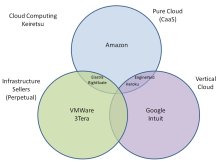Will customers demand open clouds?


(The picture is a greatly-reduced image from Smoothspan, which wrote about cloud keiretsu back in 2008.)
It is easy to tell if a device is open or closed. If you don't know right away the media will tell you. The iPhone is closed. The Android is open. We can debate how open and how closed all day. That's what journalists do.
But clouds? Right now the only really active business cloud is Amazon's. You can make it pretty open. You can install Linux on it.
The idea of the cloud, however, was to make questions about open and closed irrelevant through virtualization. When it comes to the cloud, open includes the power to run closed.
IBM is big into clouds, more as a mainframe replacement than a service, and while its clouds grok open source, they still make a choice. They run Red Hat's version of KVM virtualization. Dave Rosenberg says they will also support VMWare, but it's clear that they align with Red Hat.
But is that all that matters? Matt Asay says whether your sync is open matters more than your cloud's virtualization scheme. Cloud support for open sync systems like Funambol is what counts to him.
You start to see the problem. How can we demand an open cloud if we don't know what open means? That's why Microsoft can claim its cloud is open. Because it's interoperable with open source. Microsoft has always defined open in terms of interoperability.
We have come a long way from last year's debate over an Open Cloud Manifesto. We have come a long way in terms of the market. We have traveled less distance in terms of the debate.
Until open source advocates agree on what open means in terms of the cloud, clouds will evolve in ways that give lip service to open as an ideal, but still enforce vendor lock-in.
So what makes a cloud open to you?